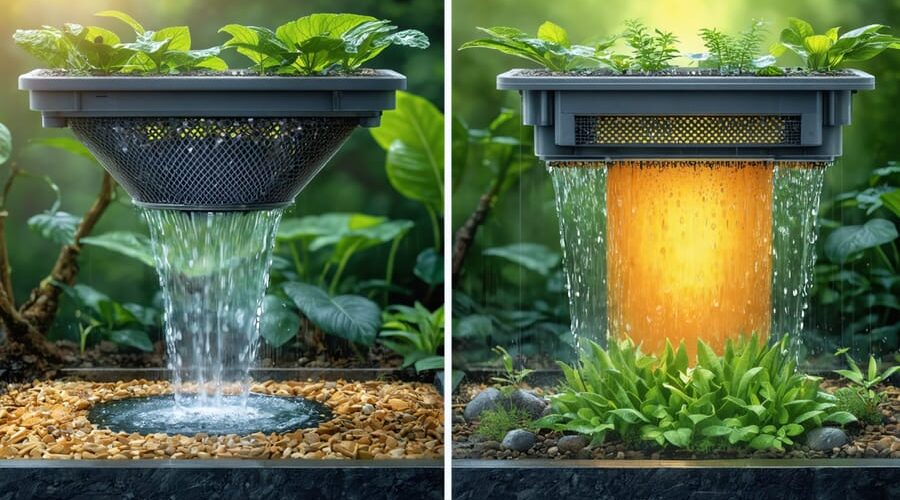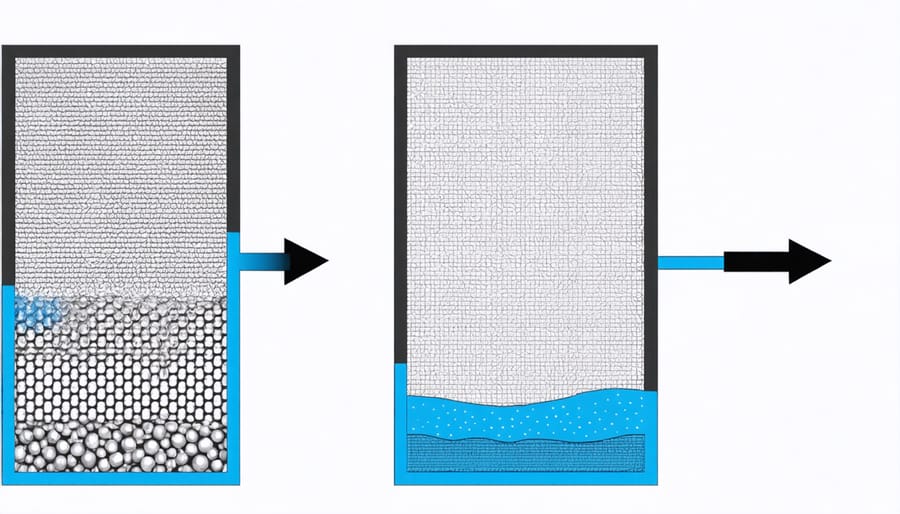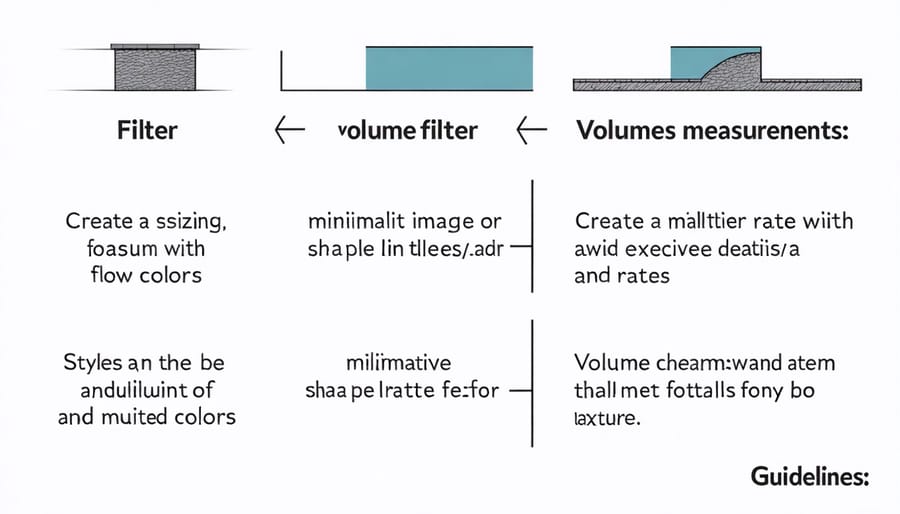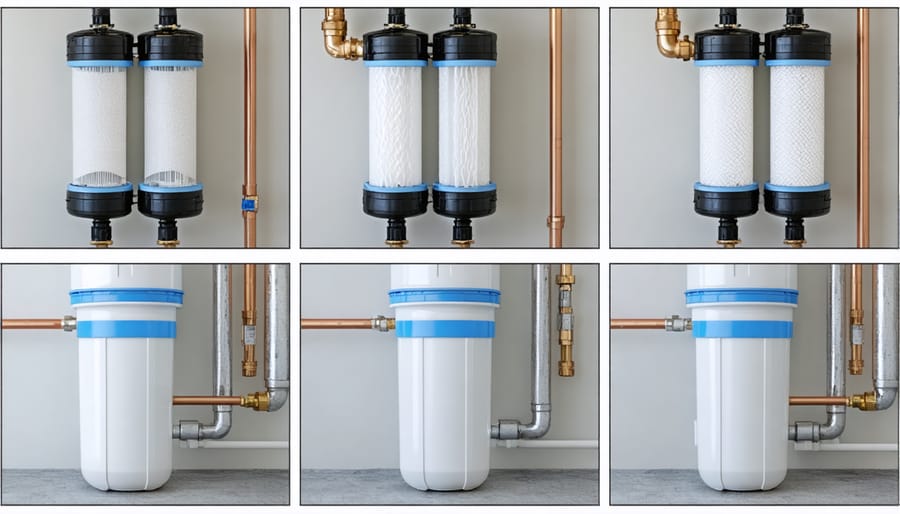
Crystal Clear Water Features: Smart Filtration That Actually Works
Transform your water feature from cloudy to crystal-clear with proper filtration – the heart of any successful pond, fountain, or waterfall. Whether you’re installing a new system or upgrading an existing one, getting filtration right makes the difference between a thriving aquatic ecosystem and a maintenance nightmare.
Modern water feature filtration combines mechanical and biological processes to remove debris, neutralize harmful compounds, and maintain healthy water chemistry. A well-designed system works quietly in the background, requiring minimal intervention while creating the perfect environment for plants, fish, and beneficial microorganisms.
Understanding filtration basics doesn’t have to be complicated. From simple pump-and-filter setups for small fountains to advanced multi-stage systems for large ponds, today’s options cater to every need and budget. The key lies in matching your filtration method to your water feature’s size, usage, and specific requirements.
This comprehensive guide walks you through everything you need to know about water feature filtration – from selecting the right components to maintaining peak performance throughout the seasons. Whether you’re a DIY enthusiast or just getting started with water gardening, you’ll find practical solutions to keep your water feature clean, healthy, and beautiful.
Understanding Water Feature Filtration Basics
Mechanical vs. Biological Filtration
When it comes to how water features work, there are two main types of filtration working together to keep your water crystal clear. Mechanical filtration is like a bouncer at a club – it physically catches and removes debris like leaves, dirt, and other particles from your water. Think of it as a series of increasingly fine nets that trap everything from large twigs to tiny particles.
Biological filtration, on the other hand, is nature’s way of cleaning water. It relies on beneficial bacteria that break down harmful substances like ammonia and nitrites into less harmful compounds. These helpful microorganisms live in your filter media and work tirelessly to maintain water quality. They’re especially important in features with fish or plants.
Together, these filtration types create a complete cleaning system. The mechanical filter catches the stuff you can see, while the biological filter handles the invisible nasties that can cause water problems. For best results, you’ll want both types working in harmony in your water feature.

Chemical Filtration Options
Chemical filtration plays a vital role when biological and mechanical filters need extra support. Most commonly, activated carbon is used to remove unwanted colors, odors, and dissolved organic compounds from your water feature. It works like a magnet, attracting and trapping these unwanted elements to keep your water crystal clear.
When should you consider chemical filtration? If your pond water has a yellow or brown tint, strange odors, or if you’re dealing with medication residue after treating sick fish, chemical filtration can help. You can add activated carbon to your existing filter system using media bags, or install a dedicated chemical filter chamber.
Other chemical filtration options include zeolite, which helps control ammonia levels, and phosphate removers that prevent algae growth. However, these should be used sparingly and only when necessary, as overuse can upset your water feature’s natural balance.
Remember that chemical filtration media needs regular replacement – typically every 2-3 months – to maintain its effectiveness. It’s best to think of chemical filtration as a helpful addition to your main filtration system rather than a standalone solution.
Choosing the Right Filtration System
Size Matters: Calculating Your Needs
Getting the right filter size for your show-stopping water features is crucial for maintaining crystal-clear water. The good news is that calculating your filtration needs isn’t rocket science – it just requires a few simple measurements and calculations.
Start by measuring your water feature’s volume in gallons or liters. For rectangular ponds, multiply length × width × average depth. For circular features, use πr² × depth. If your pond has an irregular shape, estimate as best you can or consult a pond calculator online.
As a general rule, your filter should be able to process the entire volume of water every two hours. This means if you have a 1,000-gallon pond, you’ll need a filter rated for at least 500 gallons per hour (GPH). However, if you have fish or lots of plants, consider doubling this capacity to account for the extra biological load.
Don’t forget to factor in your waterfall or fountain height when choosing a pump to pair with your filter. For every foot of vertical lift, you’ll need additional pump power. A good tip is to add 10% to your calculated GPH for each foot of height to ensure proper flow.
Remember, it’s better to slightly oversize your filter than to undersize it. A larger filter means less frequent maintenance and better water quality overall.

Feature-Specific Solutions
Different water features require specific filtration solutions to maintain their beauty and functionality. Fountains typically need smaller, integrated filters that focus on catching debris and maintaining water clarity. Since fountains usually have smaller water volumes, filters for small water gardens work perfectly for these features.
Ponds demand more comprehensive filtration systems due to their larger volume and complex ecosystem. They need both mechanical filtration to remove debris and biological filtration to handle fish waste and maintain healthy water chemistry. A combination of skimmers and external filters works best for most garden ponds.
Waterfalls present unique challenges because of their constant water movement. They benefit from pre-filter boxes at the top to catch debris before it enters the main pond, plus additional filtration at the collection basin. The good news is that waterfalls naturally aerate the water, which helps with biological filtration.
For pondless features, like disappearing waterfalls, underground reservoir systems with built-in filtration are ideal. These systems keep the water clean while maintaining the illusion of water vanishing into the landscape.
Remember that the size of your feature directly impacts your filtration needs – larger features require more powerful systems, while smaller ones can operate efficiently with compact solutions.
Installation and Maintenance Tips
DIY Installation Steps
Installing your water feature filtration system doesn’t have to be complicated. Follow these straightforward steps for a successful setup:
1. Position your pump at the lowest point of your water feature. This ensures optimal water collection and circulation. Place it on a flat surface or brick to prevent debris accumulation.
2. Connect the pump to your filter using appropriate-sized tubing. Make sure all connections are secure and waterproof. If needed, use hose clamps for extra security.
3. Install your filter according to its specific type:
– For submersible filters, place them near the pump but away from heavy debris areas
– For external filters, position them slightly above water level for easy maintenance
– For biological filters, ensure proper elevation for gravity flow
4. Create a dedicated space for your UV clarifier if you’re using one. Install it between the pump and filter, ensuring it’s protected from direct sunlight and weather exposure.
5. Set up your return line where water will flow back into the feature. Consider creating multiple return points for better circulation.
6. Hide equipment and tubing using rocks, plants, or other natural elements while ensuring easy access for maintenance.
7. Before final assembly, dry-fit all components to confirm proper placement and flow.
8. Fill your water feature and run the system, checking for leaks or air pockets.
9. Make final adjustments to achieve desired water flow and aesthetics.
Remember to always follow manufacturer guidelines for specific equipment and double-check all connections before running your system. Start with a lower flow rate and adjust as needed for optimal performance.

Maintenance Schedule and Tasks
Regular water feature maintenance is essential for keeping your filtration system running efficiently. Here’s a practical schedule to follow:
Weekly Tasks:
– Check water levels and top up if needed
– Remove visible debris from skimmers and filters
– Monitor pump operation and water flow
– Look for any unusual noises or changes in water quality
Monthly Tasks:
– Clean or rinse filter media thoroughly
– Check pump intake for blockages
– Test water parameters (pH, ammonia levels)
– Inspect all connections and hoses for leaks
– Clean surrounding areas to prevent debris accumulation
Seasonal Tasks:
– Spring: Deep clean all components after winter
– Summer: Increase cleaning frequency during peak algae growth
– Fall: Remove falling leaves more frequently
– Winter: Prepare system for cold weather if applicable
Troubleshooting Tips:
– Weak water flow? Check for clogged filters or pump issues
– Cloudy water? Clean filters and consider adding beneficial bacteria
– Strange noises? Look for air in the system or pump problems
– Green water? Balance nutrients and ensure proper filtration
For optimal performance, replace filter media annually or as recommended by the manufacturer. Keep spare parts on hand for quick repairs, and always turn off the power before performing maintenance. If you notice persistent issues, it’s better to address them promptly rather than waiting for major problems to develop.
Common Filtration Problems and Solutions
Identifying Filter Issues
Keeping your water feature crystal clear starts with recognizing when your filtration system needs attention. The most obvious sign is cloudy or green water, which typically indicates that your filter isn’t keeping up with debris and algae growth. If you notice leaves and debris floating on the surface long after they’ve fallen in, this suggests your skimmer or mechanical filtration might be clogged.
Pay attention to unusual sounds from your pump – gurgling or louder-than-normal operation often means there’s air in the system or the filter needs cleaning. A reduction in water flow from your fountain or waterfall is another telltale sign that something’s not right. This usually happens when the filter media is packed with debris or when the pump intake is partially blocked.
Watch out for strong algae smells or floating algae particles, as these indicate your biological filtration might not be working effectively. If you see fish gasping at the surface (in pond setups), this could mean poor water circulation due to filtration issues.
Check your filter regularly for any visible damage, cracking, or leaking around seals and connections. During regular maintenance, if you notice the filter media breaking down faster than usual or becoming mushy, it’s time for replacement. Remember, catching these issues early makes them much easier to fix and helps maintain a healthy water feature.
Quick Fixes and Long-term Solutions
When your water feature starts showing signs of trouble, there are both quick fixes and lasting solutions to consider. For immediate relief from cloudy water, adding a clarifier can help particles clump together for easier filtration. If you notice excess algae, a UV clarifier can provide swift results while you work on long-term solutions.
For lasting results, consider upgrading your filtration system with a combination of mechanical and biological filters. Adding more plants to your water feature naturally filters water and competes with algae for nutrients. Installing a pre-filter or skimmer can dramatically reduce maintenance by catching debris before it breaks down.
If you’re dealing with persistent issues, increasing the flow rate of your pump or adding an additional pump can improve circulation and filtration efficiency. Creating a dedicated bog filter area with specific filtration plants can provide excellent natural filtration while adding visual interest to your feature.
For smaller water features, consider implementing a simple gravity-fed filter system that’s easy to maintain. Larger features might benefit from a pressurized filter system with multiple stages of filtration. Remember to regularly clean your filters and maintain proper water chemistry – these habits prevent most filtration problems before they start.
Regular water testing and seasonal maintenance schedules are your best defense against recurring filtration issues. By combining these quick fixes with long-term solutions, you’ll create a sustainable system that keeps your water feature clean and healthy year-round.
Maintaining proper filtration in your water feature is essential for creating a healthy, vibrant aquatic environment that you can enjoy for years to come. Throughout this guide, we’ve explored the various types of filtration systems, from basic mechanical filters to advanced biological solutions, and learned how each plays a crucial role in keeping your water crystal clear and balanced.
Remember that successful water feature maintenance isn’t just about installing the right system – it’s about consistent care and attention. Regular cleaning of your filters, checking water quality, and addressing issues promptly will help prevent larger problems down the road. Make it a habit to inspect your filtration system weekly and perform thorough maintenance monthly.
Don’t be discouraged if you need to adjust your filtration setup as your water feature evolves. As plants grow and ecosystems develop, your filtration needs may change. Stay flexible and willing to adapt your system accordingly.
The reward for maintaining proper filtration is a beautiful, low-maintenance water feature that provides endless enjoyment. Clean, clear water not only looks better but also supports healthier aquatic life and requires less intervention over time. By following the guidelines we’ve discussed and staying committed to regular maintenance, you’ll be well on your way to creating the perfect backyard oasis.
Take pride in your water feature and let proper filtration be the foundation of its success. Your dedication to maintenance will pay off in countless hours of peaceful enjoyment beside your pristine water feature.
